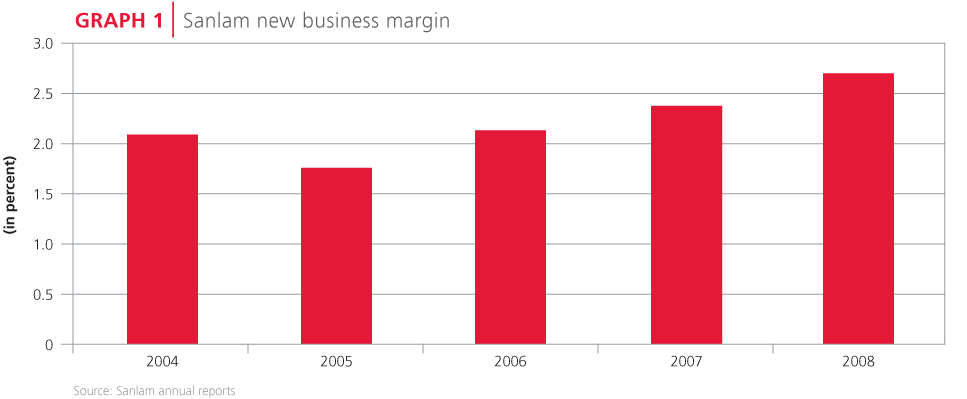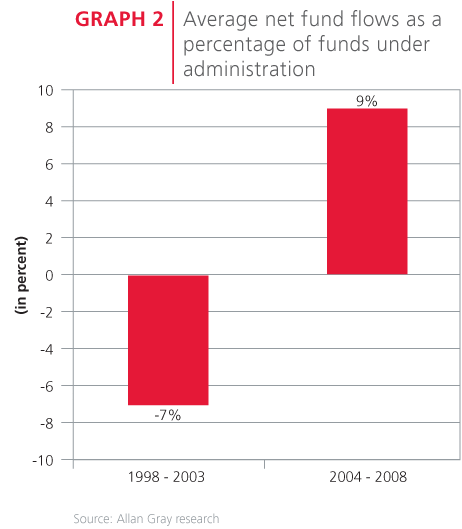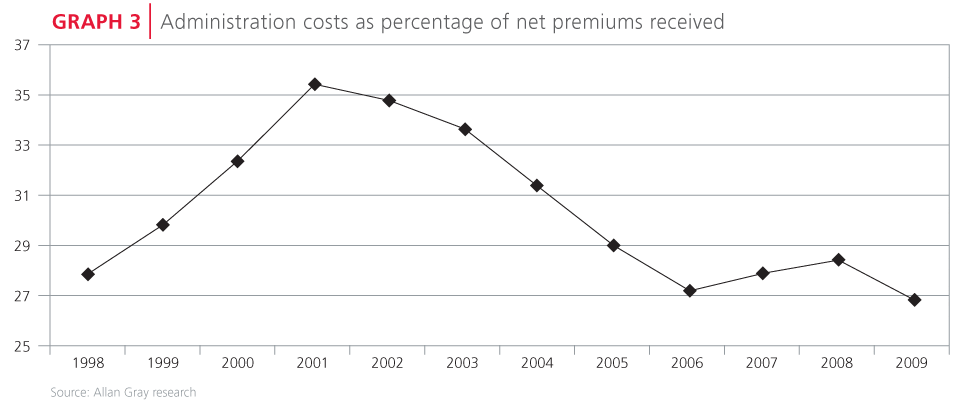The recent financial crisis was a stark reminder of the impact that management has on the wellbeing of a financial services business. With complex products and flexible capacity, a short-term focus is more tempting than in other industries. Shareholders are easily fooled by complex dynamics reflected in aggregate numbers and the real cost of growth is often revealed only much later. The evidence of sensible long-term focused management at Sanlam, combined with an attractive margin of safety, justifies its large weighting in our clients' portfolios.
The focused 'back to basics' strategy is working and bodes well for the future
The South African life insurance industry is mature, with 12.5% of our GDP received in premiums annually. Only Taiwan (12.9%) and the United Kingdom (12.8%) exceed this percentage. Within this context shareholders are best served by management not pursuing aggressive growth strategies, but focusing rather on the basics:
- Careful pricing
- Retaining clients
- Managing costs
Sanlam group chief executive Johan van Zyl is well known for his focused 'back to basics' strategy. This strategy is now bearing fruit and bodes well for long-run shareholder returns.
1. Careful pricing
Unlike other industries, the cost of an insurance product at point of sale is not known because statistical estimates such as life expectancy and client retention influence the total cost of a policy. With prices based on uncertain future costs, in the search for growth, companies can be tempted to buy market share - finding data to justify charging less. Sanlam's focus on return on capital causes them to view any product as a project that should deliver a high enough Internal Rate of Return (IRR) on its own to justify its existence after taking distribution costs into account and adjusting for risk. This focus has created steadily increasing profitability. It should also protect the business from the temptation of chasing volume in the future. One indicator of pricing discipline is the estimated margin that the business makes at the point of sale on newly sold products. This estimated margin has been increasing in recent years as shown in Graph 1.

2. Retaining clients
Life insurance is capital intensive if upfront sales commissions to financial advisers are considered as capital expenditure. For a pure life insurance policy these upfront costs can be as high as the first year's premiums received from a customer. Retaining existing customers is therefore an attractive alternative compared with acquiring new business from competitors.
A good way to retain clients is to make sure that you take on the right ones from the start. Sanlam use a statistical model to screen potential savings-policy clients for the probability that the product is suitable for them and that it justifies their upfront costs in buying the policy.
Sanlam's focus on retention has effectively turned around net fund flows, with for example, the Sanlam Personal Finance division now retaining 46% of policy maturities within the group. Graph 2 shows how the group's net client cash flows have improved over the last five years. The graph shows the difference between inflow of funds and outflow of funds for the group as a whole as a percentage of average assets administered and excludes the effect of market movements.
 3. Managing costs
3. Managing costs
Until 1998, Sanlam was run as a mutual company. Within this corporate structure there was never sufficient incentive to control costs because policyholders owned the company. After demutualisation in 1999 the strategic focus of the business was on expansion into other industries, not on costs. Corporate strategy started focusing on the cost structure when Johan van Zyl took over in 2003. Since then, the business has reduced costs in real terms with the same number of people administering more premiums.
Graph 3 reflects how administration costs have been declining relative to the value of premiums administered. These savings are even more significant in light of start-up costs (expensed in the income statement) for establishing significant new operations:
- Sanlam Developing Markets (provides insurance to the entry level market in South Africa, other parts of Africa and India)
- Sanlam Glacier (upper middle market financial services)
- MiWay (direct insurer)
Although this does not form part of our investment case, it is reasonable to expect future cost savings due to the development of synergies within the group over time. An example of this is the shared administration between Sanlam and its 57% owned subsidiary Santam.
Valuation
The value of a life insurance business is made up of two parts: equity and the insurance business. Instead of buying plants and machinery, shareholders' equity is required by the regulator to back the possible fluctuation in claims on its insurance book. Insurers provide a self-evaluation of their business called Embedded Value, with Sanlam reporting a valuation called Group Equity Value (GEV). The valuation of the insurance book attempts to capture all future cash-flows including an allowance for taxes, central costs and a charge for shareholders putting their capital at risk. Although we always approach valuations from a variety of perspectives, Sanlam's stated GEV is used as a reference point in Graph 4.
We believe Sanlam's GEV valuation is conservative relative to our market because:
- The valuation of the life business includes only the book of existing business while Sanlam has written profitable new business for at least 10 years.
- Sanlam's insurance earnings are of a higher quality than those of its competitors since it capitalises less point of sale commissions and, in spite of this, it is effectively valued at only eight times earnings after allowing for head office costs. The FTSE/JSE All Share Index is trading on a PE of 17 times.


- Sanlam's investment division is valued at 11 times 2009 earnings while the low contribution of performance fees in this year and the cash generative nature of an asset manager should justify a higher valuation.
- Sanlam's management is incentivised by the return achieved on the GEV valuation and thus it is not in their interest to overstate historical valuations.
A significant position for Sanlam in our clients' portfolios
Although there are various risks such as further market penetration of unit trusts and a consumer-friendly regulator threatening the listed life insurers, the long-term focused management at Sanlam and an attractive margin of safety justifies a significant position for Sanlam in our clients' portfolios.